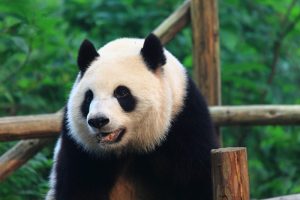
11 Days Chengdu and Lhasa World Culture Heritage Tour

Tour Overview
This 11 Days Chengdu and Lhasa Tour will take you to first experience the top attractions of Chengdu, including Chinese Buddhism in Leshan, Mt. Emei and Chengdu Panda Breeding and Research Center. Then,...
Code of Tour: YCT0000000149
Length of Travel: 11 Day
Destinations of Tour: Chengdu-Qinghai-Tibet train-Lhasa-Gyangtse-Shigatse
Departure City: Chengdu
Price of Tour: Request
Type of Tour:
Features of Tour: Nature Panda Culture History Landscape
This 11 Days Chengdu and Lhasa Tour will take you to first experience the top attractions of Chengdu, including Chinese Buddhism in Leshan, Mt. Emei and Chengdu Panda Breeding and Research Center. Then, take the overnight train to Lhasa with grasslands, snow mountains, plateau lakes, Tibetan villages and rare animalspassing by. After arrive at Lhasa, you will visit several significant monasteries in tibet, including Potala Palace and Jokhang Temple in Lhasa and Kubum Monastery in Shigatse. Also pay a visit to Yamdro-tso Lake–the green jade lake above the pasture.
Highlights:
- Visit the top attractions of Chengdu including Leshan Buddha and the Panda Breeding and Research Center.
- Take the overnight Trian to Lhasa with the most beautiful sceneries passing by.
- Experience Tibetan Buddhism in significant monasteries in Lhasa.
- Meet the tranquil lakes, white snow mounatians, shimmering rivers and rare animals in Lhasa.
Brief Itinerary
- Day 1: Chengdu Arrival
- Day 2: Chengdu-Leshan-Mt.Emei
- Day 3: Mt. Emei-Chengdu
- Day 4: Chengdu-Lhsa
- Day 5: On the Train
- Day 6: Lhasa Arrival
- Day 7: Lhasa
- Day 8: Lhasa
- Day 9: Lhasa-Gyantse-Shigatse
- Day 10: Shigatse-Lhasa
- Day 11: Lhasa Departure
Google Map
Detailed Itinerary
Day 1 Arrive in Chengdu
Sightseeing and Activities:Arrive in Chengdu
Accommodation:Chengdu
Meals:None
Upon arrival in Chengdu airport, you will be transferred to your hotel in Chengdu. The rest of the day is at leisure. Stay overnight in Chengdu.
Day 2 Chengdu-Leshan-Mt.Emei
Sightseeing and Activities:Drive from Chengdu to Leshan Giant Buddha and Stay overnight at the foot of Mt. Emei
Accommodation:Mt. Emei
Meals:Breakfast, Lunch
In the morning, drive about 2 hours from Chengdu to Leshan to have an overlook at the famous Giant Buddha by boat. The grand Buddha carved out of the cliffs at the confluence of the Dadu, Minjiang and Qingyi Rivers. You will take a sightseeing cruise to the center of the river and face the huge stone Buddha.
In the afternoon, drive from Leshan to Mt. Emei to visit Baoguo Temple at the foot of Mt. Emei, known as one of the four sacred Buddhism mountains in China and added to UNESCO’s Natural and Cultural Heritage List in 1996. Baoguo Temple is the largest temple on the mountain. Later, you can enjoy a hot spring bath at the foot of Mt. Emei. There are many hot springs near the Baoguo Temple, such as Hongzhu Hot spring Clubhouse, Lingxiu Hot Niton-spring, Yoga Hot Spring of Mt. Emei Hotel, etc. Stay overnight at the foot of Mt. Emei.
Day 3 Mt.Emei-Chengdu
Sightseeing and Activities:Visit Mt. Emei and drive back to Chengdu
Accommodation:Chengdu
Meals:Breakfast, Lunch
In the morning, visit the famous Mount Emei. Many ancient temples are scattered in the deep mountain, and the nature is beautiful. Dense forest, naughty monkeys, clean rivers and something else are beyond your expectation! With an elevation of over 3,000 meters above sea level, Golden Summit is the highlight of Mount Emei and an important attraction integrating the temples and scenic sites together.
After breakfast, move on to the entrance to Mt. Emei and take bus and cable car to the Golden Summit. Standing on the Golden Summit, you are truly among the clouds, as clouds can be seen above and below you. You might have the good fortune to see Cloud Sea even Buddha light if it is a nice day. After having an eyeful of the spectacular view at the Golden Summit, you can take the cable car down and the bus back to Wannian parking lot which is located halfway of Mt. Emei. Take another cable car to visit Wannian temple where you can have a simple lunch. Then walk along the scenic mountain path for around two hours to another parking lot to take a bus out of the Mt. Emei Scenic Area. Drive back to your hotel in Chengdu. Stay overnight in Chengdu.
Day 4 Chengdu-Lhasa
Sightseeing and Activities:Visit Chengdu Panda Breeding and board Stay overnight train to Lhasa
Accommodation:Nione
Meals:Breakfast, Liunch
In the morning, drive for about half an hour to Chengdu Panda Breeding and Research Center, the home to giant pandas, where you will catch pandas’ feeding time. They are at their most active, both Adults and Babies. There’s a wealth of information and a panda museum in this 230-hectare park 10 km (6 miles) north of Chengdu. It takes about 2.5 hours to visit this site.
Then, In the afternoon you will be transferred to Chengdu train station for the overnight train to Lhasa. The train departs from Chengdu North Railway Station. It takes about 1 hour to check in as the train takes about 1000 passengers. Please be sure to arrive in train station 1 hour or a half before the train departure. Train Z322 from Chengdu to Lhasa departs at 14:48, and your Tibet Permit will need to be checked when you check in. Stay overnight in the train.
Day 5 On the train
Sightseeing and Activities:On the train
Accommodation:None
Meals:Breakfast, Lunch
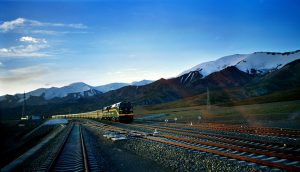
Spend the whole day on the train to Lhasa. It is quite a long journey of taking a train from Chengdu to Lhasa. It will take 44 hours, two days and two nights in the Train. On the first day you will pass through two important provincial capital cities in northwest China, Lanzhou and Xining. Xining is known as the beginning of Qinghai-Tibet Railway. Travelling along the rail line, you could see the scenery of countryside and cities in northwest China. The last stop for today is Xining, where you will arrive in about 17:00. Stay overnight in the train.
Day 6 Lhasa
Sightseeing and Activities:Enjoy beautiful scenery along Qinghai-Tibet Railway, arrive in Lhasa and transfer to hotel
Accommodation:Lhasa
Meals:Breakfast, Lunch
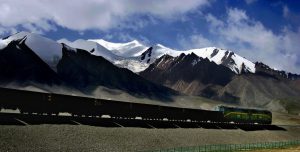
Enjoy the most beautiful scenery of Qinghai-Tibet Railway. Spectacular land of snows, boundless desert, vast grassland, grand ice mountains, beautiful lakes that will continually appear and strongly attract your heart. You will arrive in Lhasa at about 16:00. Your tour guide will hold a board with your name to welcome you at the exit of the train station and escort you to your reserved hotel in Lhasa. Stay overnight in Lhasa.
Day 7 Lhasa
Sightseeing and Activities:Potala Palace, Tibet Museum, Jokhang Temple, Barkhor Street
Accommodation:Lhasa
Meals:Breakfast, Lunch
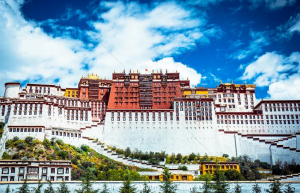
In the morning, visit the famous Potala Palace and explore the grandest of this myriad chapel. You will appreciate its audience halls, the jeweled and Golden burial chortens (stupa Tombs) of past Dalai Lamas, and tremendous number of Buddhist frescoes, thangkas, combinations of mandala, etc. Tibet Museum is an important window to introduce the glorious culture of Tibet, and as a free Museum in Lhasa, you should not miss.
In the afternoon, visit the holist temple in Tibet, the Johkang Temple, built during Songtsen Gonpo’s reign by princess Wencheng of Tang Dynasty, 647 A.D, and its famous Barkor Kora, where you can buy or appreciate traditional Tibetan artifacts, religious implements, antiques, books, Tibetan music instrument, Thangkas, and tradition Tibetan clothes etc. You will have a chance to get close to appreciate how the artists draw Thangkas at the Thakangka workroom at Barkor Street. Stay overnight in Lhasa.
Day 8 Lhasa
Sightseeing and Activities:Drepung Monastery, Sera Monastery
Accommodation:Lhasa
Meals:Breakfast, Lunch
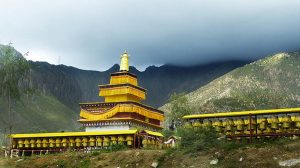
Visit two important monasteries in Lhasa, the Drepung and the Sera. Drepung Monastery is situated at the foothill of a mountain and was founded by Jamyang Choeje in 1416. It was once home to10000 monks and Ganden podrang in Drepung is famous as it was the government centre and later moved to the famous Potala palace during the fifth dalai lama. After lunch, continue to visit the Sera Monastery, which was founded in 1419 by Tsongkapa’s disciple Jamchen Choeje. The most attractive is its Buddhist Scriptures debating held in the courtyard mostly around 6:00 – 7:30 in the afternoon. Stay overnight in Lhasa.
Day 9 Lhasa-Yamdrotso Lake-Gyangtse-Shigatse
Sightseeing and Activities:Lhasa-Yamdrotso Lake-Gyangtse-Shigatse
Accommodation:Shigatse
Meals:Breakfast, Lunch
Passing by the green farmland of Nyangchu Valley(Niyang River), Yamdro-tso Lake, Karo-la Glacier roadside at 4960m, we move westwards to the second biggest city of Tibet, Shigatse, the area spiritually hosted by Pamchan Lama. The most important attraction for today is Yamdro-tso Lake and Kubum Monastery(Pelkor Chorten) in Gyantse. Yamdro-tso Lake is shaped like coiling scorpion with deep blue in color and Kubum monastery has a 35m-high chorten (stupa) with its white layers trimmed with decorative stripes and its crown-like golden dome. Stay overnight in Shigatse.
Day 10 Shigatse-Lhasa
Sightseeing and Activities:Shigatse to Lhasa:Tashilunpo monastery
Accommodation:Lhasa
Meals:Breakfast, Lunch
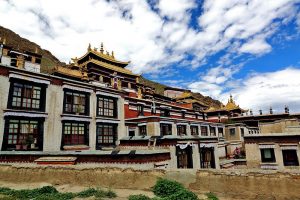
Before spending about 4 hours driving back to Lhasa from Shigatse, we will visit the largest Monastery in west Tibet-theTashilhunpo Monastery, as the last but famous historic sites for your Tibet tour. Tashilunpo monastery is one of the six great Gelukpa institutions and was founded in 1447 by a disciple of Tsongkapa, containing the world’s largest gilded copper image (26m high) of future god Jampa. Drive along the Friend-ship Highway back to Lhasa. Stay overnight in Lhasa.
Day 11 Depart from Lhasa
Sightseeing and Activities:Depart from Lhasa
Accommodation:None
Meals:Breakfast
Transfer to the airport or train station. Service ends.
Recommended Hotels
| Destination | 5 Star | 4 Star | 3 Star |
| Chengdu | Crowne Plaza | Tianfu Sunshine Hotel | Garden City Hotel |
| Lhasa | Luxury St. Regis Lhasa Resort | Lhasa Gang Gyan Hotel | Lhasa Xiongbala Hotel |
| Shigatse | / | Shigatse Manasarovar Hotel | Jiumu Yamei Hotel in Shigatse |
Service Included:
-
Tibet travel permit and all other necessary permits to Tibet;
-
All entrance ticket fees for all tourist sites listed in the itinerary;
-
Personal knowledgeable English-speaking Tibetan local tour guide;
-
Personal comfortable, clean and safe vehicle with reliable Tibetan local driver; vehicle ranging from 4WD land cruiser to minibus depending on your group size;
-
All lodging listed in the itinerary; it’s your decision about the accommodation class: luxury 5-star international hotel, comfortable 4-star hotel, economic 3-star hotel or budget hostel, guesthouse or tent. Please tell us your accommodation preference when submitting the enquiry; we will arrange the best-value hotels for you.
-
Domestic flight/train tickets listed in the itinerary;
Service Excluded:
-
International flight to and out of China;
-
Chinese visa (Note: we could help you with the Chinese visa application, like providing the invitation letter, presenting the hotel or domestic flight reservation copies, etc that you may need. )
-
Domestic flight/train not listed in the itinerary. (We can provide you the domestic flight/train ticket booking service at the BEST discount price; please contact us our travel experts for the details.)
-
Meals not specified in the itinerary; usually it costs about USD3-15 per person for one meal in TAR (Tibet Autonomous Region).
-
Tips and gratitude to tour guide and driver;
-
Personal expenses, like laundry, phone call, snacks, soft drinks (please do the best to avoid the alcoholic beverages during your Tibet trip), optional tour activities, etc.
Travel Tips:
- Tibet Permits
There are several permits required to visit Tibet. Tibet Entry Permit, issued by Tibet Tourism Bureau, is the most important one which has to be obtained before your trip because you must have it to take your flight/train to Tibet. To get the permit, you have to book a Tibet tour with us, and send us your passport and Chinese visa about 20 days in advance, and then let us apply for the permit (all Tibet permits can only be applied by travel agency). If you travel to other prefectures like Shigatse, Nyingchi, Shannan, etc, you also have to obtain an Alien Travel Permit. If you travel to Mount Everest, you have to obtain a Border Permit. (Tibet Discovery, with office in Lhasa, has always kept up with the latest news on Tibet Permits. Traveling with us, all your permits are guaranteed as long as you are qualified to the requirements.)
- Available Months to Visit Tibet
Generally speaking, May to early October is the best time to for a Mount Kailash trip. July and August are the peak season and rainy season. It may be too cold to travel in Kailash area from November to March. There is usually heavy snow. The conditions in Namtso Lake and Mount Everest area are quite similar with Kailash. While other places like Lhasa, Gyantse and Shigatse are suitable for travel all year around.
- High Altitude Sickness
The average altitude of Tibet is about 4000 meters above the sea level (Lhasa: 3700m; EBC: 5200m; Namtso: 4718m). You may suffer a bit from High Altitude Sickness in the beginning days of your Tibet trip if you haven’t had rich high plateau travel experience. But don’t worry too much, the high altitude can be acclimatized usually in 2~3 days. Our suggestion is to take a physical examination and get suggestions from your doctor, and also bring some medicines to prevent from High Altitude Sickness before your trip. While in Tibet, you should keep warm all the time, avoid strenuous activities, drink more water and eat more vegetables and carbohydrates. You’d better not take showers during the first two days after your arrival at Tibet. If you don’t feel well, get help from your tour guide or go to the hospital without any delay.
- How to Go to Tibet
Basically you have two options – flight and train. Currently, you can take a flight to Lhasa from Beijing(4.5hrs), Xian(3.7hrs), Chengdu(2.5hrs), Chongqing(3hrs), Kuming(3hrs), etc. Among all these cities, Chengdu and Xian have more frequent flights to Lhasa. Kathmandu also has several flights to Lhasa each week.
If you a train travel, you can take a train to from Beijing(40.5hrs), Xian(32hrs), Chengdu(43hrs), Shanghai(47hrs), Chongqing(42hrs), Lanzhou(25hrs), Xining(22hrs), Guangzhou(54hrs).
- Packing and Wearing Ideas
Firstly you can’t forget your passport and Chinese Visa. A large backpack and a smaller one are recommended (the smaller one can be used for daily activities). Also bring the necessary medicine you need. Other stuffs like sunglasses, snow glasses, hats, lip balm, sun block are recommended. As for wearing, you are suggested to dress in layers (both thin and thick jackets). Down jacket is necessary in Spring and Autumn. A pair of durable and comfortable shoes is necessary.



